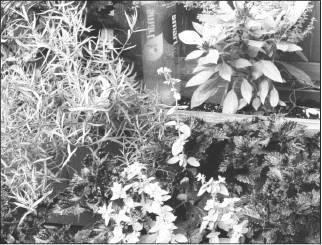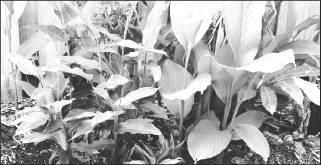Drippin’ Gardening
Summer is gone, and fall has arrived. As has the Central Texas allergy season. Ragweed is in the air, with the recent rain molds are high too and load of us are suffering with itchy red eyes, runny noses, sinus headaches, aches and pains, and for some, even life-threatening asthma.
When the sneezing starts, more people than ever are reaching for the over the counter eye drops, pills, or nose sprays for relief. Some even need prescription strength meds or allergy shots just to be able to get through the day.
The number of sufferers of seasonal allergic rhinitis is increasing rapidly, with the current rate of one in four nearly double what it was in the 1980s. Experts predict by 2030, half the population will suffer hay fever’s bothersome symptoms, with increasing pollution and wacky weather making things even worse.
With seasonal allergies as predictable as they are annoying, it is surprising that more people don’t know how to harness the power of herbs for fast allergy relief with no drugs needed. But fear not, I’m here to help with a quick primer for those who wish to give it a go when allergies
Seasonal allergies are ultimately the uncomfortable result of a very confused immune system. Flowering plants release tiny grains known as pollen. These tiny particles, which are only about one millionth of an inch across, are released into the air by trees, flowers, grasses, garden veggies, and weeds, for the purpose of fertilization and propagation of their species.
When these grains are inhaled into the nose of someone with hay fever, the immune system is thrown into hyperdrive. The protein coat on each grain of pollen is what causes the allergic reaction, and in some people, it can be extremely violent with the body mounting the same type of response as if it were being invaded by pathogenic bacteria or a deadly virus.
While most people automatically reach for over the counter or prescription meds for seasonal sniffles, herbs can provide allergy relief that is just as effective without any nasty or dangerous side effects and toxicity. It amazes me that more people don’t use herbs for simple allergy relief. It works great for me!
The only real drawback is that you really ought to start using herbs a week or so before pollen gets bad and keep using them faithfully throughout the entire allergy season. You can start using herbs once symptoms have already started, but you will need to be patient until the full power of the herbs kicks in. The reason is that it takes a few days to build up levels of the herb’s anti-inflammatory properties in your blood and tissues, so immediate relief like what would happen from taking a modern, highly concentrated drug is usually not experienced although you may see a slight improvement in symptoms right away.
Following is a list of the herbs I use for allergy relief.
First off is Turmeric. It is a product of Curcuma longa, a perennial plant belonging to the ginger family. Native to tropical South Asia, you can grow your own here in Central Texas. Turmeric is known as the golden spice because of its brilliant yellow color and seemingly endless applications as safe, nontoxic herbal medicine including use as a natural antibiotic. Modern medicine has begun to recognize its importance, as indicated by the over 3000 publications dealing with turmeric that have come out within the last 25 years!
To defend against the symptoms of seasonal allergies, grow your own or look for pure, organic turmeric either off the spoon chased with water, mixed into a beverage or food (like raw, local honey), or in capsule form. Dosages of 400 to 600 mg taken three times daily or as directed by your physician should do the trick.
Next in my herbal bag of tricks is Rosemary, it grows everywhere in our area and is great for helping allergy suffers. High in rosmarinic acid, rosemary effectively treats allergies because of its antioxidant properties. "Rosemary's flavor is pungent, somewhat piney, and mintlike," says Michael J. Balick, PhD, author of Rodale's 21st-Century Herbal. " Fresh sprigs of rosemary and rosemary flowers can be steeped in vinegar or wine to add a subtle flavor. Use rosemary branches as skewers for grilling meat and vegetable kebabs."
Also keep in mind that rosemary offers other medical benefits besides clearing up your wheeze. "The herb is used primarily to treat poor digestion and appetite, joint pain, and sluggish circulation," Balick says. Use it in cooking meats, stews, soups and in baking breads too!
My third go-to herb for allergy relief is Sage. "Sage tastes lemony, camphor-like, and pleasantly bitter," says Balick. This herb can be mixed into any meal—breakfast (omelets), lunch (soups and beans), or dinner (pasta and poultry). "Sage is excellent for sore throats, coughs, and colds," he adds. "For a unique and tasty appetizer or accompaniment for potatoes, dust larger sage leaves with flour, then fry them in a quarter-inch of hot oil for about 30 seconds, until crispy." Who says your medicine can’t be tasty!
My final favorite garden herb for allergies is Shiso. While it is an herb that most folks have not yet heard of, it grows well in our area and more and more people are discovering it every day. Shiso is in the mint family and is also known as perilla, beefsteak plant, Chinese basil and purple mint.
I first encountered shiso at a farmers’ market booth. Run by a local Vietnamese couple who have given me a wealth of knowledge about their traditional herbal remedies. Every weekend throughout the year the table in their booth is buried under organic and affordable produce. Bunches of duck’s foot herb, mounds of bok choy, citrusy bundles of lemongrass, fragrant bushels of mint, and mountains of fresh yellow-green limes all call to any shopper with a keen eye.
For the first time, however, sat two verdant hedges of cut herbs with wide, ragged leaves. Looking like celery leaves that had been hitting the gym, they were soft and somewhat downy to the touch. When pressed they released a sweet fragrance: a strange combination of mint, basil, lemon, and cumin. Next to it sat a crinkly, burgundy-colored companion that smelled somewhat similar but with a certain cinnamon note.
“The red one is good for tea,” said their young daughter running the stall.
I inquired as to what the two herbs were. “Shiso leaf,” she informed me. “Red and green.”
Shiso is a prominent part of Asian medicine and culinary garnishes, it is especially effective against seafood allergieswhich is convenient considering that most sushi is served with this green leaf on the side (it's often holding the wasabi). Shiso is also a common treatment for bronchial asthma.
To understand the taste of shiso leaf, you have to try it yourself. Herbaceous? Citrusy? A hint of mint? Or is that basil? I might say cilantro, but haters of cilantro aren't necessarily opposed to shiso. The taste is an interesting and unique one. These nice folks even gave me a potted plant of my own, which I promptly killed. Or so I thought, but soon I learned that much like other members of the mint family, shiso spreads!
Stick to pharmaceuticals alone if you wish, but I would much rather follow the advice of Hippocrates, the father of modern medicine and, “Let thy food be thy medicine.”






